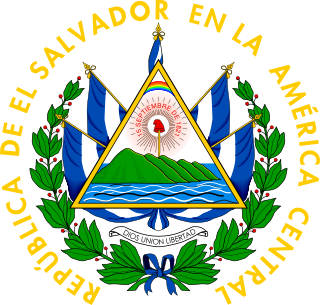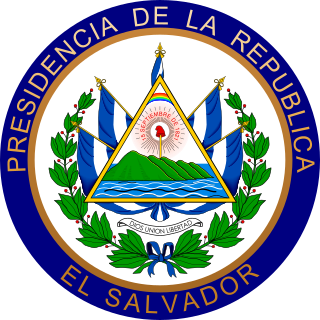| |||||
| Decades: | |||||
|---|---|---|---|---|---|
| See also: | |||||
The following lists events that happened in 1936 in El Salvador .
| |||||
| Decades: | |||||
|---|---|---|---|---|---|
| See also: | |||||
The following lists events that happened in 1936 in El Salvador .

El Salvador, officially the Republic of El Salvador, is a country in Central America. It is bordered on the northeast by Honduras, on the northwest by Guatemala, and on the south by the Pacific Ocean. El Salvador's capital and largest city is San Salvador. The country's population in 2023 was estimated to be 6.5 million.

Politics of El Salvador takes place in a framework of a presidential representative democratic republic, whereby the President of El Salvador is both head of state and head of government, and of an executive power is exercised by the government. Legislative power is vested in both the government and the Legislative Assembly. The Judiciary is independent of the executive and the legislature. The Economist Intelligence Unit rated El Salvador a "hybrid regime" in 2022.

The history of El Salvador begins with several Mesoamerican nations, especially the Cuzcatlecs, as well as the Lenca and Maya. In the early 16th century, the Spanish Empire conquered the territory, incorporating it into the Viceroyalty of New Spain ruled from Mexico City. In 1821, El Salvador achieved independence from Spain as part of the First Mexican Empire, only to further secede as part of the Federal Republic of Central America two years later. Upon the republic's isolation in 1841, El Salvador became sovereign until forming a short-lived union with Honduras and Nicaragua called the Greater Republic of Central America, which lasted from 1895 to 1898.

The president of El Salvador, officially titled President of the Republic of El Salvador, is the head of state and head of government of El Salvador. He is also, by constitutional law, the commander-in-chief of the Armed Forces of El Salvador. The office was created in the Constitution of 1841. From 1821 until 1841, the head of state of El Salvador was styled simply as Head of State.

Maximiliano Hernández Martínez was a Salvadoran military officer and politician who served as the president of El Salvador from 4 December 1931 to 28 August 1934 in an acting capacity and again in an official capacity from 1 March 1935 until his resignation on 9 May 1944. He was the leader of El Salvador during World War II. While he served as President Arturo Araujo's vice president and defense minister, a directorate seized power during a palace coup and afterwards named Hernández Martínez president of El Salvador.

Rafael Antonio Gutiérrez was the president of El Salvador from 10 June 1894 to 13 November 1898. He was a leader of the Revolution of the 44 which overthrew President General Carlos Ezeta from April to June 1894. He served as provisional president until being officially inaugurated in March 1895 after his victory in the 1895 presidential election, in which he was the only candidate.

Legislative elections were held in El Salvador on 12 March 1972. The result was a victory for the National Conciliation Party, which won 39 of the 52 seats. However, the election was marred by massive fraud and the Central Election Council disqualified the candidates of the opposition National Opposing Union in five out of fourteen constituencies. Voter turnout was 56.7%.

Legislative elections were held in El Salvador on 8 March 1970. The result was a victory for the National Conciliation Party, which won 34 of the 52 seats. However, the election was marred by massive fraud. Voter turnout was just 41.6%.

Legislative elections were held in El Salvador on 15 May 1956. The result was a victory for the Revolutionary Party of Democratic Unification, which won all 54 seats.

Constitutional Assembly elections were held in El Salvador on 17 December 1961. The result was a victory for the National Conciliation Party, which won all 54 seats.

Legislative elections were held in El Salvador on 8 March 1964. The result was a victory for the National Conciliation Party, which won 32 of the 52 seats.

Presidential elections were held in El Salvador on 5 March 1967. The result was a victory for Fidel Sánchez Hernández of the Party of National Conciliation, who won 54.4 percent of the vote.

Presidential elections were held in El Salvador on 20 February 1972.

Legislative elections were held in El Salvador in January 1936, however, no results were published.

The Salvadoran military dictatorship was the period of time in Salvadoran history where the Salvadoran Armed Forces governed the country for almost 48 years from 2 December 1931 until 15 October 1979. The authoritarian military dictatorship limited political rights throughout the country and maintained its governance through rigged and fixed elections.

Nayib Armando Bukele Ortez is a Salvadoran politician and businessman who is the 43rd president of El Salvador, serving since 1 June 2019. He is the first president since José Napoleón Duarte (1984–1989) not to have been elected as the candidate of one of the country's two major political parties: the left-wing Farabundo Martí National Liberation Front (FMLN) and the right-wing Nationalist Republican Alliance (ARENA).

The National Party of the Fatherland, usually translated as the National Pro Patria Party or simply the Pro Patria Party, was a far-right political party which was the sole-legal political party in El Salvador from its establishment in 1933 until its dissolution in 1945. The party was founded by President General Maximiliano Hernández Martínez to support his government.
Jaime Abdul Gutiérrez Avendaño was Salvadoran military officer and politician. He was one of the leaders of the 1979 Salvadoran coup d'état which overthrew President General Carlos Humberto Romero and established the Revolutionary Government Junta of El Salvador, ending 48 years of exclusive military rule in the country. The coup started the 12-year-long Salvadoran Civil War which lasted until 1992.
The following lists events that happened in 1939 in El Salvador.
The following lists events that happened in 1944 in El Salvador.